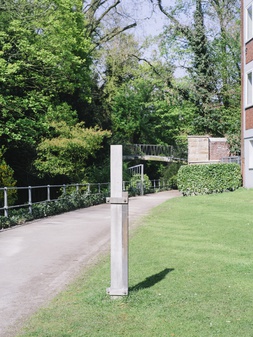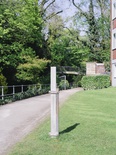Giovanni Anselmo
Verkürzter Himmel [Shortened Heavens]
1987
Engraved writing on stainless steel, galvanized zinc U-form, iron brackets
140 x 10 x 10 cm
Location
Lake Aa promenade, adjacent to the building at Johannisstr. 8–10, Katholisch-Theologische Fakultät der Universität Münster [Münster University faculty of catholic theology], permanent installation
Owner
On loan from the artist, LWL-Museum für Kunst und Kultur, Münster
Giovanni Anselmo
* 1934 in Borgofranco d’Ivrea, Italy
† 2023 in Turin, Italy
A column of bare steel stands upright on a small patch of lawn, rigidly balanced in the grasp of roughly hewn brackets, and anchored to the ground by a further iron component. That the words “Verkürzter Himmel” [shortened heavens] are engraved on top of the column is only apparent at close proximity. Giovanni Anselmo had already produced a similar work in 1969/1970 when the text was engraved in Italian: “Cielo accorciato.” On this work he commented: “I wanted to make the infinite more human, because heaven does not begin in the stratosphere, but here on earth. This is why I shortened it by a metre. That the writing is on the top of the column, and is engraved, is also of significance. I’m saying it deliberately allegorically: the heavens know that they have been shortened!”1
Shortened Heavens [Cielo accorciato] belongs to a group of works in which Anselmo addresses the limits of representation using seemingly simple interventions and which also paradoxically breaks them. The invisible is made visible, “Tutto” [everything] being shown at once.2 There is in any case more happening here: the infinite that towers beyond the stratosphere and above the Earth is spoken of as the “heavens” instead of the “sky,” shifting associations from the purely physical world to that of poetic metaphors. Anselmo even attributes these heavens with a consciousness: “the heavens know”. This aspect is strikingly extended by the sculpture’s siting directly next to the university’s faculty of Catholic theology. Within the context of Christian theology, the work develops a wide-ranging critique of the church that in 1987 was read by, for example, the supporters of the then current liberation theology as an objection to an unworldly idealist spirituality and as a visual argument for a church that would be socio-politically (left-wing) active.
Eckhard Kluth
1 “Ho voluto rendere più umano l’infinito; siccome il cielo non comincia nella stratosfera, bensì qui, sulla terra, l’ho accorciato di un po‘. Che la scritta si trovi sulla superficie superiore, e per di più incisa, ha il suo significato: il cielo sappia pure che è stato accorciato!” In: Kunsthalle Basel (publ.), exhib.cat.: Kunsthalle Basel, Basel 1979, 32. See also Klaus Bußmann and Kasper König (eds.), Skulptur Projekte in Münster 1987, exhib. cat.: Westfälisches Landesmuseum für Kunst und Kulturgeschichte, Münster, Cologne 1987, 27.
2 Gianfranco Maraniello, Margins of the Infinite. The work of Giovanni Anselmo: Introduction and Exodus. In: Gianfranco Maraniello and Andrea Viliani (eds.), Giovanni Anselmo, exhib. cat.: Museo d’Arte Moderna di Bologna, Bologna 2007, 205–208.
Location
- Still existing / Public Collection
- Removed
- In the museum

